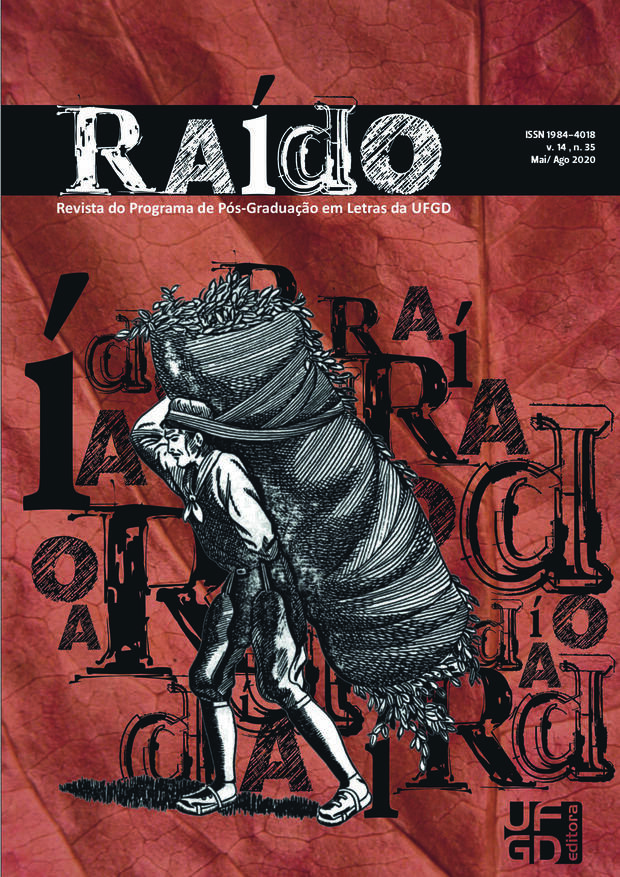Body in dis(course): domination and resistance in the Handmaid Tale
DOI:
https://doi.org/10.30612/raido.v14i35.11630Keywords:
Body. Discourse. Domination. Resistance. The Handmaid’s tale.Abstract
Interest in the body as an object of knowledge is as old as civilization. Its modes of representation have been transformed along with the discursive practices that defines. This contributed to present the body as an analytical element of social relations and as an object of representation for behaviors, attitudes, morality, aesthetics and ethics of a given socio-historical period. In this paper we undertake an analysis of interpretation gestures regarding woman subject body in the book The Handmaid’s Tale by Margaret Atwood (1985 [2017]) and the television adaptation created by Bruce Miller in 2017. As theoretical and methodological framework we follow the discursive studies of Pêcheux (2014, 2015, 2016), Orlandi (2016) and Ferreira (2013). We aim to understand in both literary and filmic versions the discursive modes of domination and resistance of/in the body. In this perspective, two discursive functions are characterized: the one of the dominated body and the one of the resistant body, the latter unfolding in two positions: subsistence body and erotic body.
Downloads
References
ATWOOD, M. E. O conto da aia. Rio de janeiro: Rocco, 2017.
BARBOSA, M. R.; MATOS, P. M.; COSTA, M. E. Um olhar sobre o corpo: o corpo ontem e hoje. Psicologia e Sociedade, 23(1), p. 24-34, 2011.
BATAILLE, G. O erotismo. Porto Alegre: L&PM, 1987.
BEAUVOIR, S. O segundo sexo: fatos e mitos. 5. ed. Rio de Janeiro: Nova Fronteira, 2019.
BUTLER, J. Corpos que pesam: sobre os limites discursivos do sexo. In: LOURO, G. L. (org.) O corpo educado: pedagogias da sexualidade. Belo Horizonte, Autêntica, 1999, p. 151-172.
BUTLER, J. Problemas de Gênero: feminismo e subversão da identidade. 11. ed. Rio de Janeiro: Civilização Brasileira, 2016.
CAMPELLO, E.; SCHMIDT, R. T. Corpo e literatura. Ilha do deserto, Florianópolis, v. 68, n. 2, p. 09-14, 2015.
DEL PRIORE, M. L. M. Dossiê: a história do corpo. Anais do Museu Paulista, v. 3, p. 9-26, 1995.
FEDERICI, S. Calibã e a bruxa: mulheres, corpo e acumulação primitiva. São Paulo: Elefante, 2017.
FERREIRA, M. C. L. O corpo como materialidade discursiva. REDISCO, v. 3, n. 1, nov. 2013.
FOUCAULT, M. Microfísica do poder. Rio de Janeiro: Edições Graal, 1979.
FOUCAULT, M. Vigiar e punir: o nascimento da prisão. 20. ed. Petrópolis: Vozes, 1987.
FOUCAULT, M. História da sexualidade: a vontade de saber. 13. ed. Rio de Janeiro: Edição Graal, 1988.
ORLANDI, E. P. Por uma teoria discursiva do sujeito. In: ORLANDI, E. P. Discurso em análise: sujeito, sentido e ideologia. 3. ed. Campinas: Pontes Editores, 2016, p.213-234.
PÊCHEUX, M. Semântica e discurso: uma crítica à afirmação do óbvio. 5. ed. Campinas: Editora Unicamp, [1975] 2014.
PÊCHEUX, M. Papel da memória. In: ACHARD, P.; DAVALON, J.; DURAND, J. L.; PÊCHEUX, M.; ORLANDI, E. P. Papel da memória. 4.ed. Campinas, São Paulo: Pontes, [2007] 2015.
PÊCHEUX, M. Metáfora e interdiscurso. In: ORLANDI, E. (Org.) Análise de discurso: Michel Pêcheux – textos escolhidos por Eni Orlandi. Campinas: Pontes Editores, 2016, p. 151-161.
SCAVONE, L. Nosso corpo nos pertence? Discursos feministas do corpo. Revista Gênero, v. 10, n. 2, p. 47-62, 1.sem. 2010.
TEDESCHI, L. A. As mulheres e a história: uma introdução teórica metodológica. Dourados: Ed. UFGD, 2012.
THE HANDMAID’S Tale. Direção: Bruce Miller. Estados Unidos: HULU, 2017. Disponível em: https://globoplay.globo.com/the-handmaids-tale/t/QDFNw11dPX/. Acesso em: 2 jun. 2019.
Downloads
Published
How to Cite
Issue
Section
License
Os autores devem aceitar as normas de publicação ao submeterem a revista, bem como, concordam com os seguintes termos:
(a) O Conselho Editorial se reserva ao direito de efetuar, nos originais, alterações da Língua portuguesa para se manter o padrão culto da língua, respeitando, porém, o estilo dos autores.
(b) Autores mantém os direitos autorais e concedem à revista o direito de primeira publicação, com o trabalho simultaneamente licenciado sob a Atribuição-NãoComercial-CompartilhaIgual 3.0 Brasil (CC BY-NC-SA 3.0 BR) que permite: Compartilhar — copiar e redistribuir o material em qualquer suporte ou formato e Adaptar — remixar, transformar, e criar a partir do material. A CC BY-NC-SA 3.0 BR considera os termos seguintes:
- Atribuição — Você deve dar o crédito apropriado, prover um link para a licença e indicar se mudanças foram feitas. Você deve fazê-lo em qualquer circunstância razoável, mas de nenhuma maneira que sugira que o licenciante apoia você ou o seu uso.
- NãoComercial — Você não pode usar o material para fins comerciais.
- CompartilhaIgual — Se você remixar, transformar, ou criar a partir do material, tem de distribuir as suas contribuições sob a mesma licença que o original.
- Sem restrições adicionais — Você não pode aplicar termos jurídicos ou medidas de caráter tecnológico que restrinjam legalmente outros de fazerem algo que a licença permita.


